Homemade Hotdogs: So Tasty, and Temperature-perfect
Hotdogs are perhaps the most quintessentially American food. Sausages of all sorts made their way here with immigrants from all cultures and were then changed, re-tuned, and altered to cope with new ingredients and fit the needs of American eaters and their increasingly unique palate. One of those sausages eventually begat the hotdog. Deeply entrenched in American culture, hotdogs are also shrouded in mystery, solely the products of giant meat machines and corporations of greater or lesser scrupulosity. But what if you could make hotdogs at home? My friends, you can.
In this post, we’ll lay out the method, science, and thermal principles behind hotdog production and show you how to make this classic American treat in your own kitchen. Do it, and you’ll get gourmet hotdogs that are fine-tuned to your liking, with your choice of cuts, that are better than almost any wiener, frank, or dog you can buy at the market. Let’s get to it!
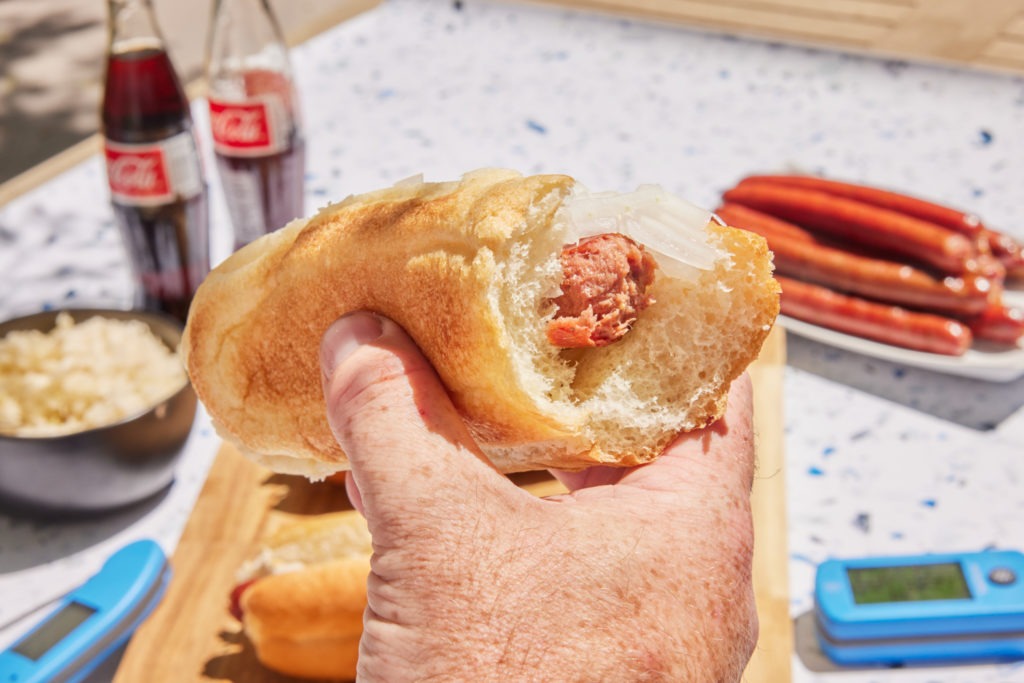
Hotdogs: A brief history and analysis
“Hotdogs” are descended from German Frankfurter sausages, named for Frankfurt the city. Frankfurters belong to the category of “forcemeat” sausages, meaning that their spiced meat is very finely ground and emulsified, producing a smooth, somewhat soft texture. Traditionally, in Germany, the resulting “farce” is stuffed into a thin casing, then simmered or boiled before serving. This “simmered sausage” (Brühwürst) does bear a strong resemblance, as an ancestor, to our modern hotdog.
The history of the hotdog’s rise in popularity in America, and more especially the innovation of the hotdog bun, is clouded in lore, myth, and bad scholarship, but we can know for sure that by the time Nathan’s Famous opened in 1916, hotdogs were well established as American food.

Though descended from the frankfurter, there are some differences between the ur-sausage and our current treat: frankfurters are usually made of pork, whereas the best American ‘dogs are usually made of beef. And franks are often served still linked, in pairs, and still in their sheep casings. While you can find paired franks in stores, they are not common—nor are hotdogs that are still in their casings.
Good dog …
That last point is an odd one, because true hotdog connoisseurs value a “snap” in the bite of their hotdog, the result of an intact casing! So if you want that snap you have to either search high and low for cased dogs—or make your own.
And while we’re making our own, we may as well make the best dog possible. But what does that mean? Well, that varies from person to person, of course, but in general, a good hotdog has the aforementioned snap, is rather highly seasoned, usually with salt, pepper, garlic, and paprika as the main flavoring components, and is lightly smoked. Of course, you can play with the seasonings to suit your taste, but if you want it to taste like a hotdog, you shouldn’t stray too far from those basics. A little mustard here, a little marjoram there, yes. But maybe steer clear of cumin and/or basil.
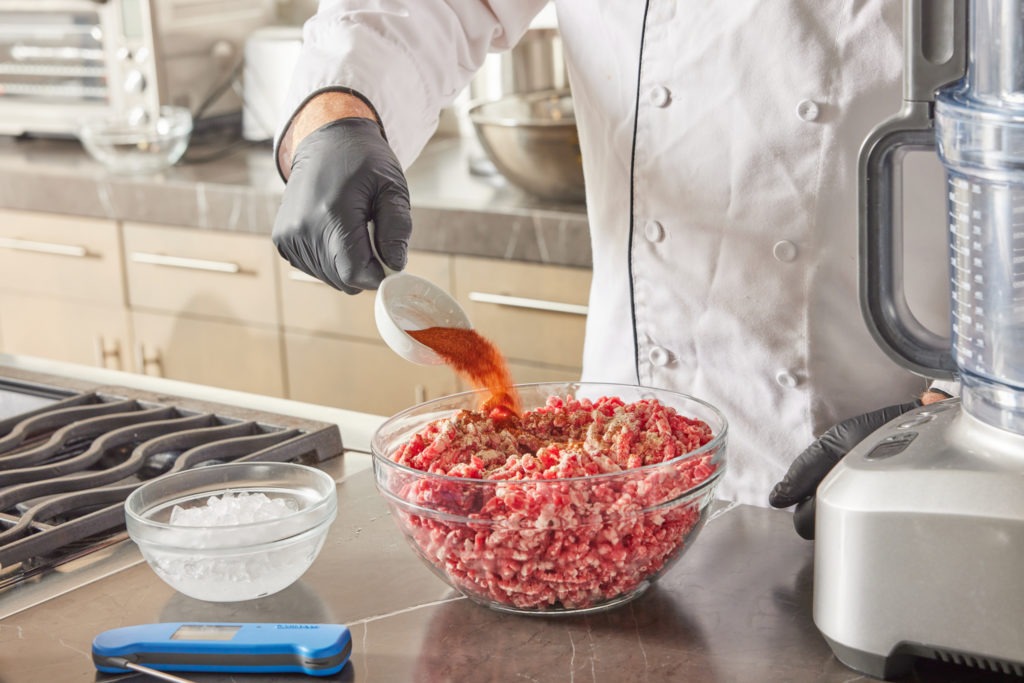
But far more important than the snap, and at least equally as important as the seasoning, is the texture of the meat itself. The forcemeat out of which hotdogs arise must be properly emulsified to prevent the meat from breaking down into a grainy, mealy mess when cooked. And this is one place where temperature really matters in the process.
Temperature for making homemade hotdogs
As with any sausage, hotdog meat must undergo an emulsion step. But it’s much more important for a forcemeat like this than for a bratwurst, say. The “forcing” can be accomplished in many ways (a food processor is easiest at home), but no matter how it is done, it needs to happen at or below 40°F (4°C). If you let the meat warm up too much, it will break the emulsion, and the stored juices and fat from the meat will run out of the sausage when you bite into it. Not what we want.
Partially freezing your meat—so it has a stiff exterior—before grinding will help, as will the addition of crushed ice or ice-cold water during the emulsification. Don’t leave it up to chance, though! Use your Thermapen® ONE in the meat and halfway through the grinding to make sure things are still cold. If the temp gets above that threshold, stop, put things in the freezer, and chill them until they’re cold enough to continue.
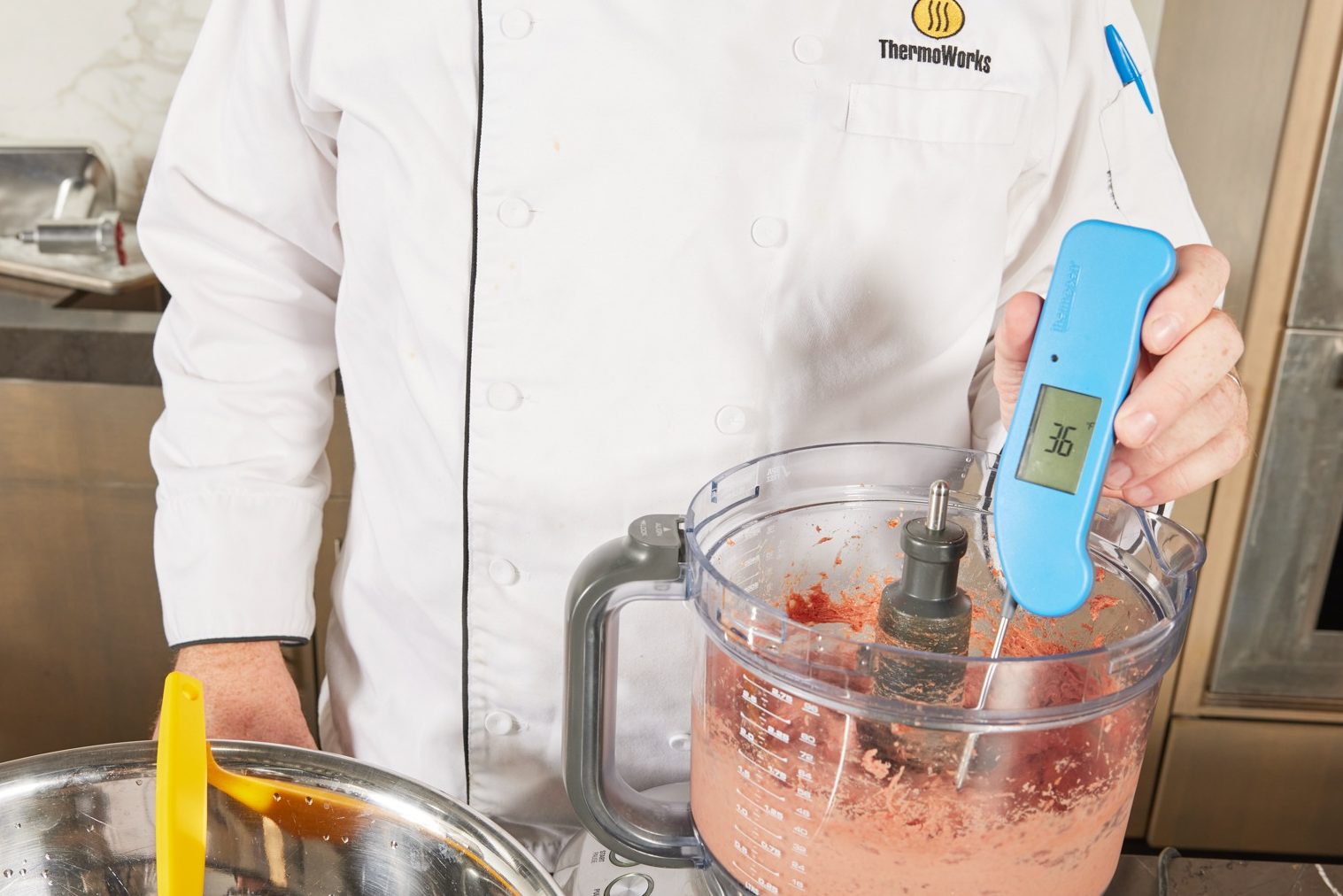
Smoking homemade hotdogs: key temperatures
Once the hotdogs are emulsified and stuffed (and have sat overnight in the fridge), you need to smoke them for optimal flavor, as well as food safety. For that, you’ll want to get your Smoke X2™ and get your smoker running at about 180°F (82°C) (use your Smoke to monitor the smoker temp) and put the hotdogs on to smoke. We don’t want to cook them too fast, because we don’t want to risk splitting the casings and we want a long enough smoke bath to season them well. Cooking low until they reach an internal temp of 145°F (62°C) is perfect. This is one place where the Pro-Series® 2.5″ Needle Probe is perfect. The tiny probe fits easily in the sausages without blemishing the hotdog.
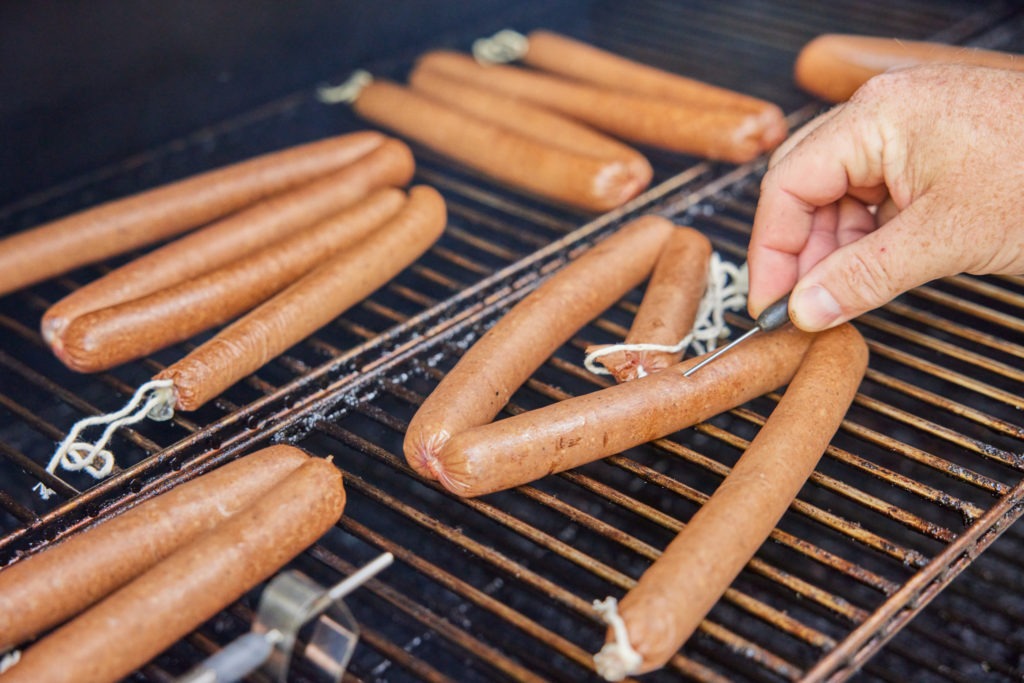
Note that smoking is not your final cook! You can take these and grill them, steam them, or even deep fry them, but they need to be fully cooked and smoked like this first. If you plan on eating some of them right away, go ahead and move them over to the grill and enjoy. Otherwise, a bath in ice water is best for cooling them quickly to ready them for fridge or freezer storage. (A water bath is even advisable if you’re cooking them right away—it’s supposed to make the skin more taut, the color better. Not necessary, but it won’t hurt anything.)
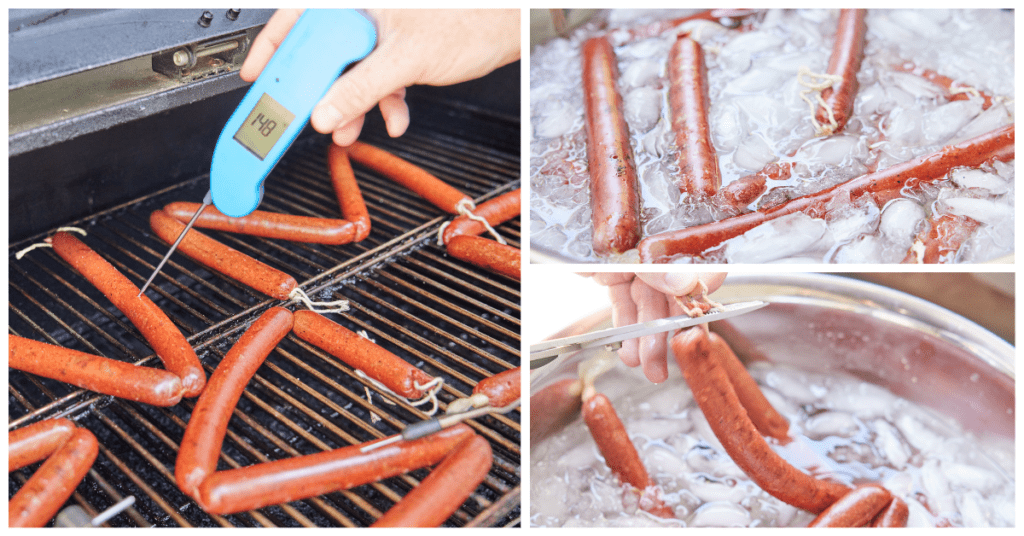
We expected making these homemade frankfurters to be somewhat arduous. But in reality, it was fun! it’s no harder than making any other sausage; you just have to use a food processor for the emulsification instead of a stand mixer, and you have to let them sit overnight in the fridge to cure. And the results? Oh, they were well worth the effort! These are quite possibly the best hotdogs any of us had ever eaten. They were flavorful, juicy, and had that perfect snap to them that we so craved—all thanks to our careful temperature monitoring. Give this a shot and bring some homemade hotdogs to your next grill-out. Happy cooking!
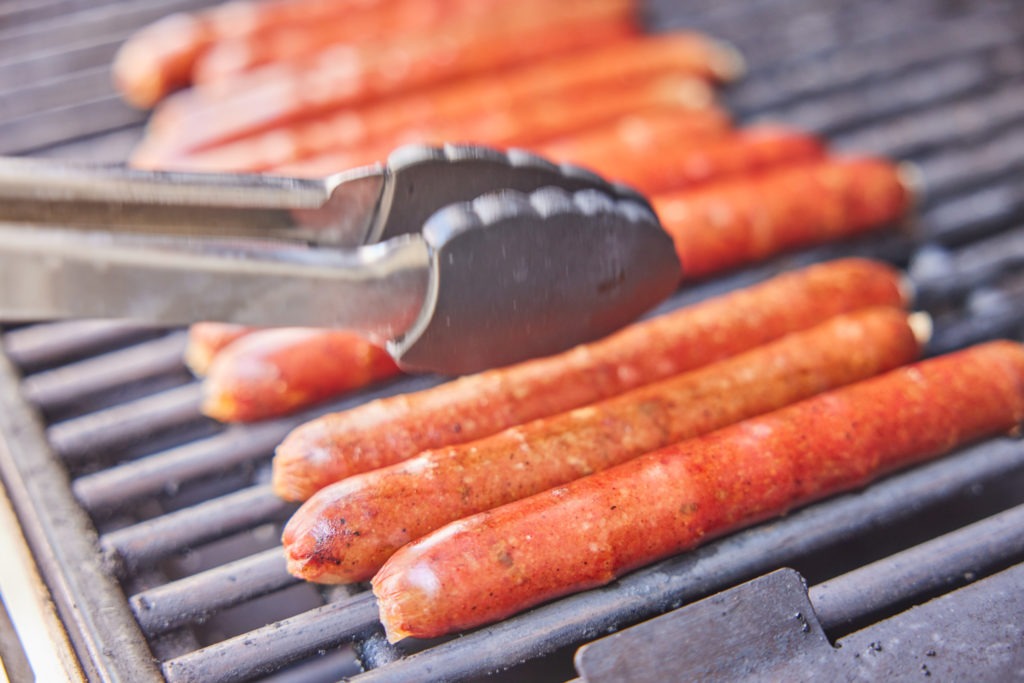
A few notes on the technicalities of homemade hotdogs
Hotdogs go in sheep casings, not hog casings. If you can’t locate sheep casing (they are readily available online), you can use thinner-bore collagen casings, usually available at the hunting/sausage/meat-processing section of your nearest large outdoors store or farmers co-op. We used the collagen and it was good, but sheep casings will be worth the extra effort to procure.
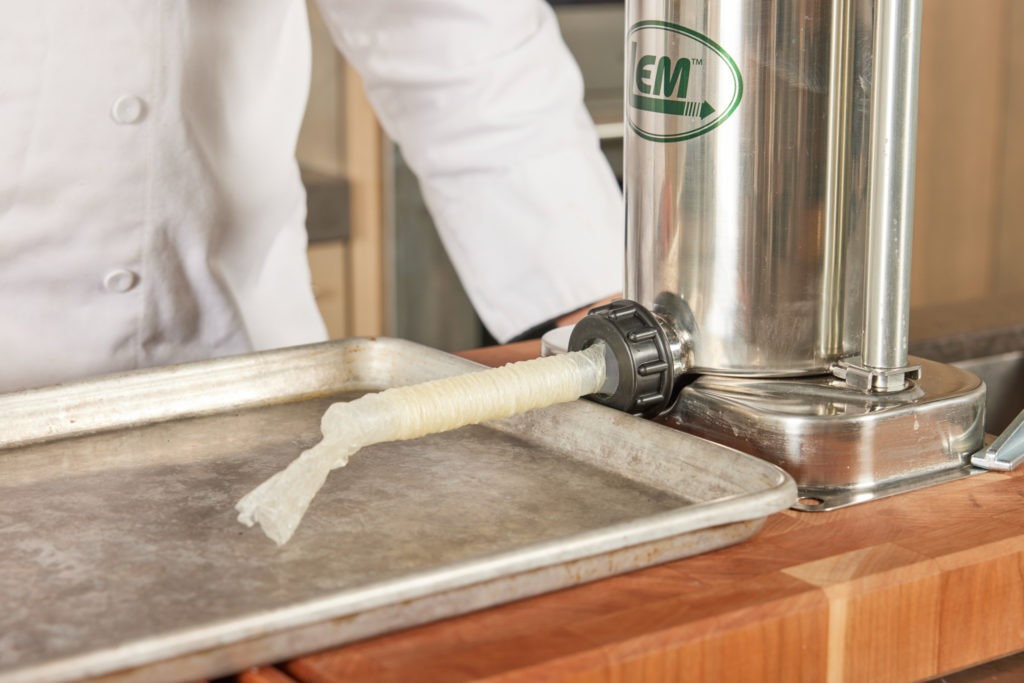
We mention the curing, and for that you need to use Prague powder #1, then let the sausages cure overnight. Without this step, your hotdogs won’t taste … hotdoggy, and they won’t have that characteristic pink/red color. The nitrites in the curing salt chemically change the proteins in the meat, preventing them from browning when cooked, and changing their flavor profile. They also prevent the development of botulism in the sausage if stored over longer periods. Measure it carefully! It is not healthy to have too much of it, and you don’t want too little for the sake of the sausage.
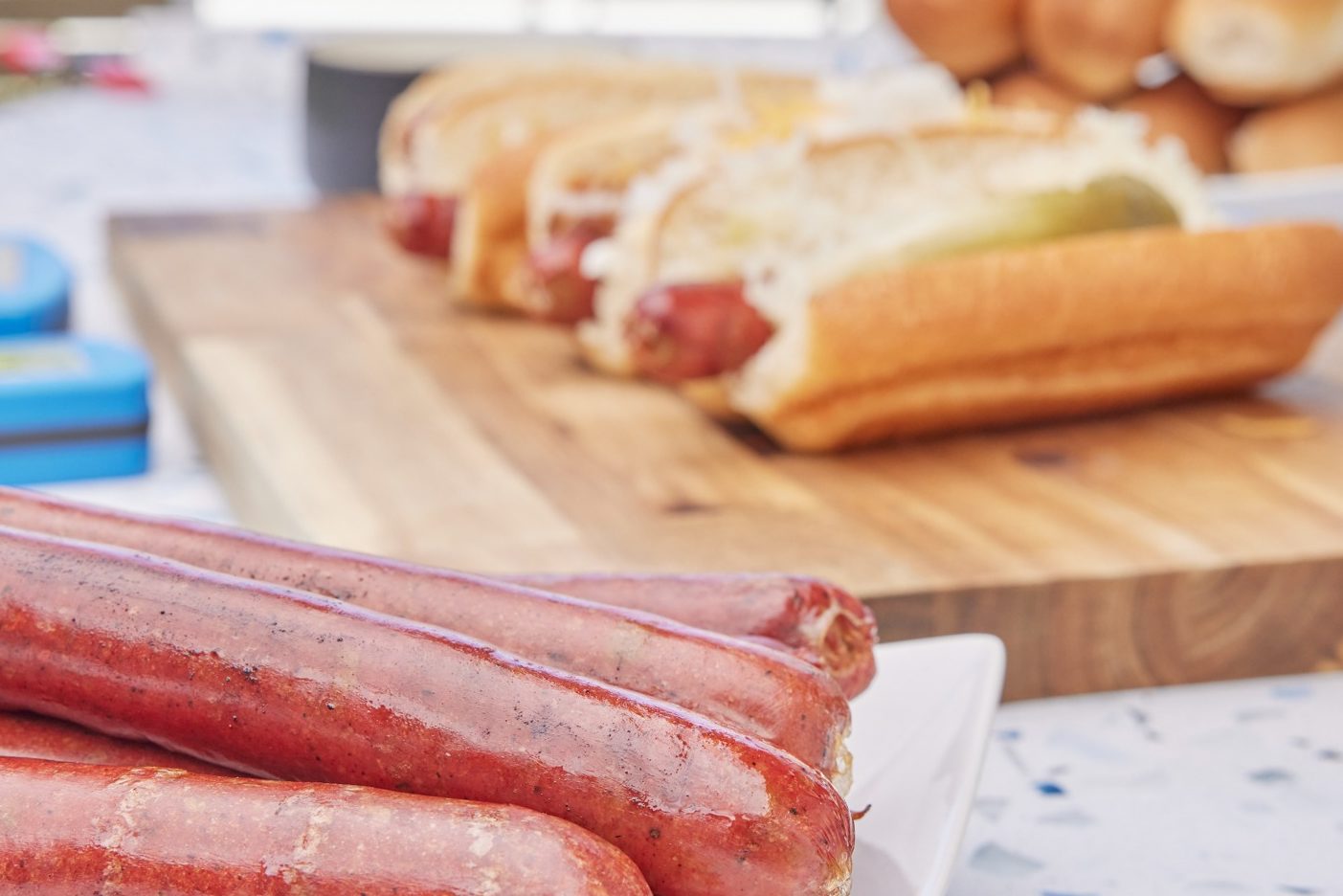

Homemade All-Beef Hotdogs Recipe
Description
Hotdogs! Adapted from Binging with Babish and Serious Eats (both of whom crib from Ryan Farr)
Ingredients
- 1150 g well-marbleized beef, cubed (we used short rib with the fat-cap on, silver skin removed)
- 23 g fine sea salt
- 10 g paprika
- 5 g garlic powder
- 5 g black pepper
- 3 g mustard powder
- 4 g onion powder
- 1.5 g pink curing salt
- 230 g crushed ice
Sheep or collagen casings for stuffing
Instructions
Make the sausages
- Measure your spices and seasonings carefully, especially the curing salt. Set them aside.
- Place the cubed meat in one layer on a parchment-lined sheet pan in the freezer for 20–30 minutes, until firm and stiff on the outside. Also freeze your grinding equipment.
- Grind your beef through a grinder with a fine or medium plate into a bowl set in a larger bowl of ice.
- Combine the ground meat with the seasonings and curing salt. Mix with your hands until the spices are evenly distributed.
- Add half of the mixture to a large food processor along with half of the crushed ice. Process until the meat is very pasty, very sticky, and well-emulsified. It will look a lot like hotdog meat! As you process, stop every 5–10 seconds to temp with your Thermapen ONE and make sure the mixture is at or below 40°F (4°C).
- Move the batch to a bowl and process the second half, also verifying the temperature.
- Mash the two batches together and mix with your hands to combine them.
- Load your sausage stuffer with your casings and stuff, trying to avoid air bubbles. (Pierce any bubbles with your Thermapen ONE.)
- Link the sausages to lengths you want. We did 7.5″ to match our buns. If using collagen casings, we find that using butcher twine for the first and last tie-off is helpful.
- Place the stuffed sausages, uncovered, in the refrigerator overnight to cure.
Smoke the hotdogs
- The next day, preheat your smoker to 180°F (82°C). Use your Smoke’s air probe to monitor the pit temp.
- Place your linked sausages in the smoker with a 2.5″ needle probe inserted into one of them. Close the lid and cook, about 45 minutes, until the high-temp alarm, set to 145°F (62°C), sounds.
- Verify the internal temperature of a few hotdogs using your Thermapen ONE.
- If they are at temp, remove them from heat, snip them apart, and either grill them immediately or give them an ice-water bath to cool them quickly and then store them.
- You made hotdogs from scratch! Get your favorite condiments out and serve them up!
Shop now for products used in this post:


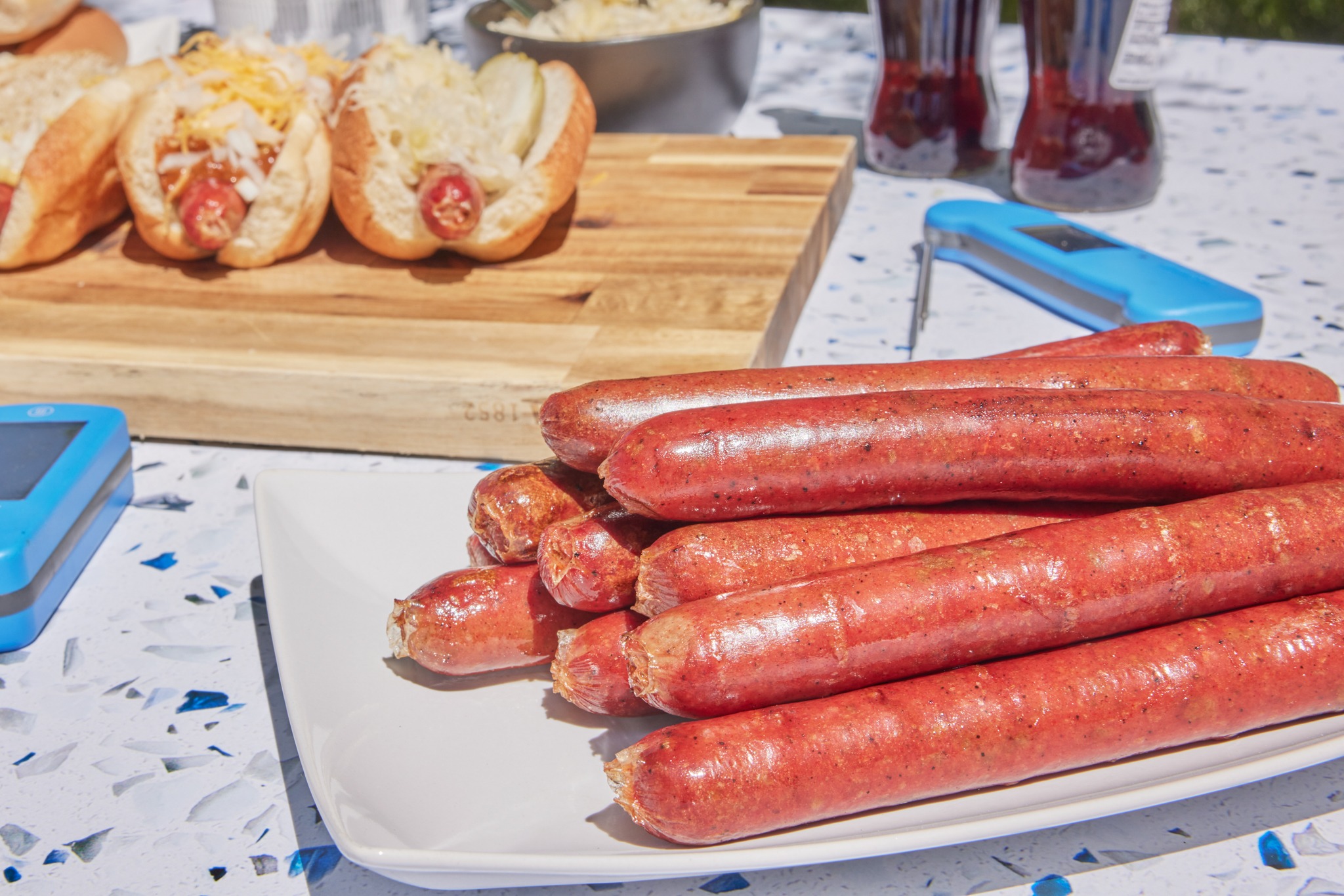
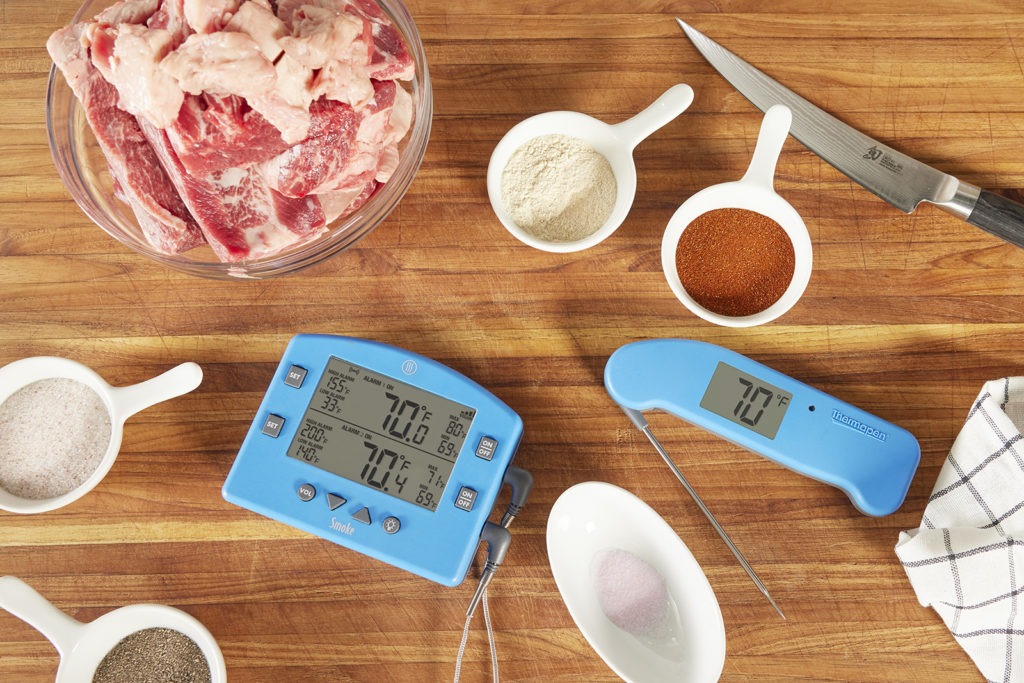
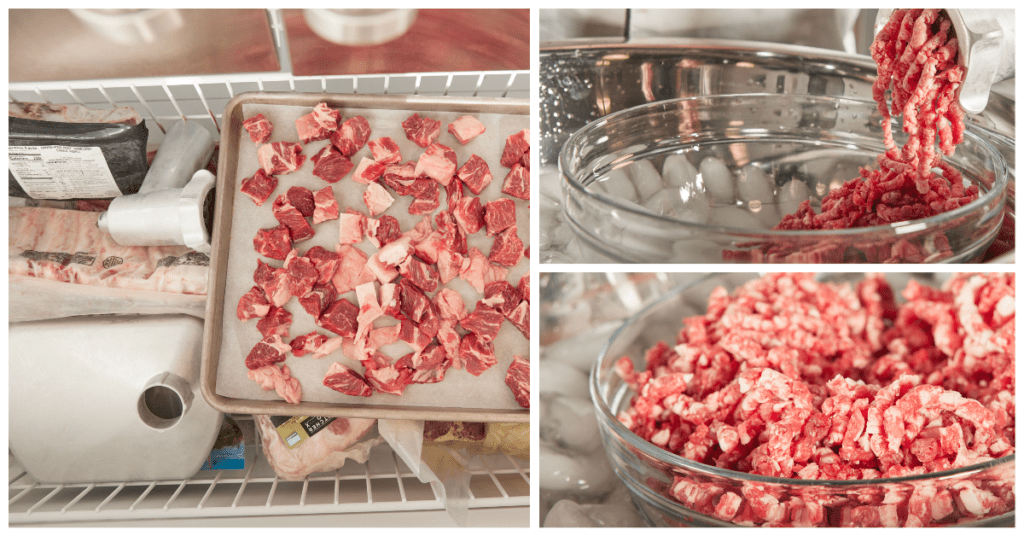
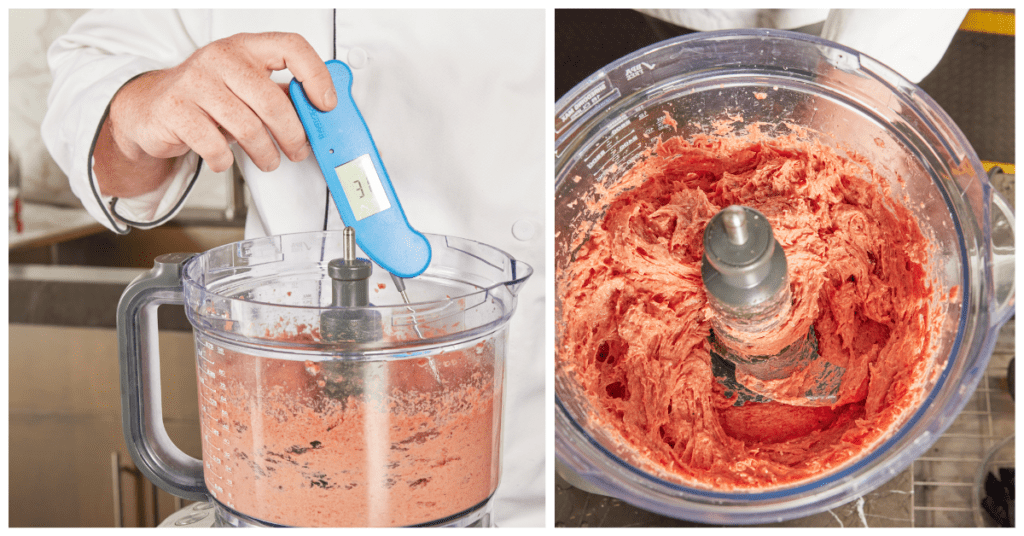
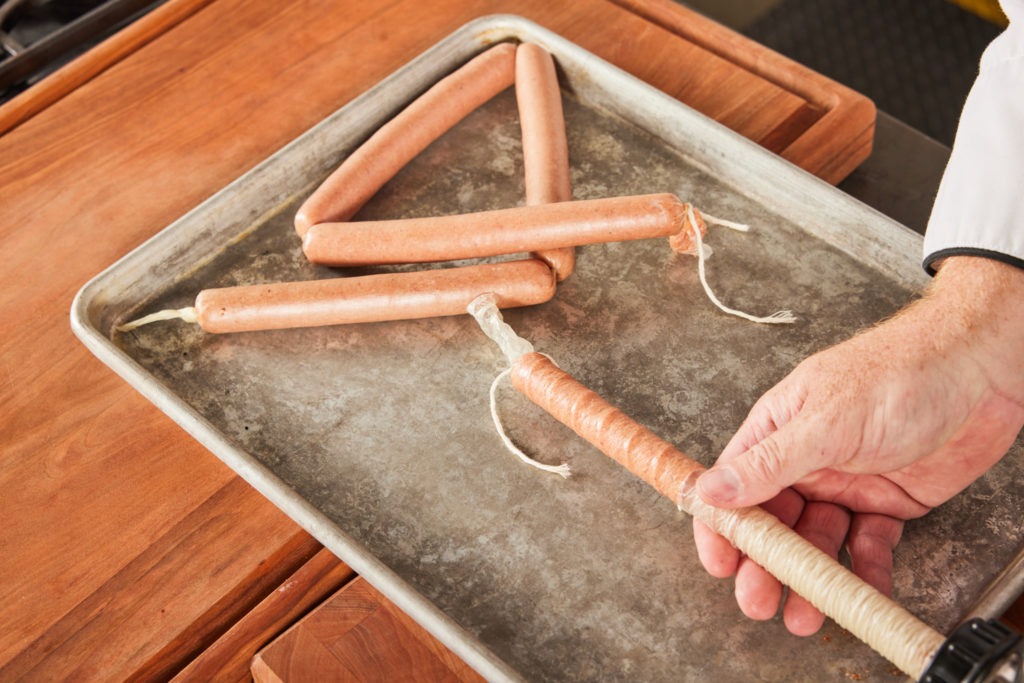
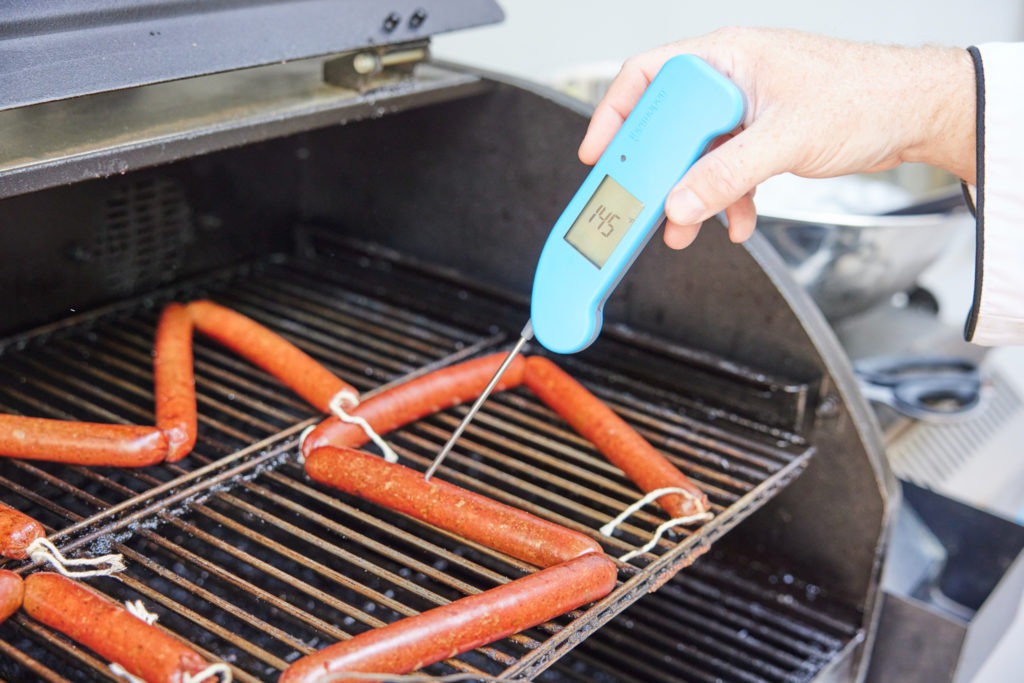

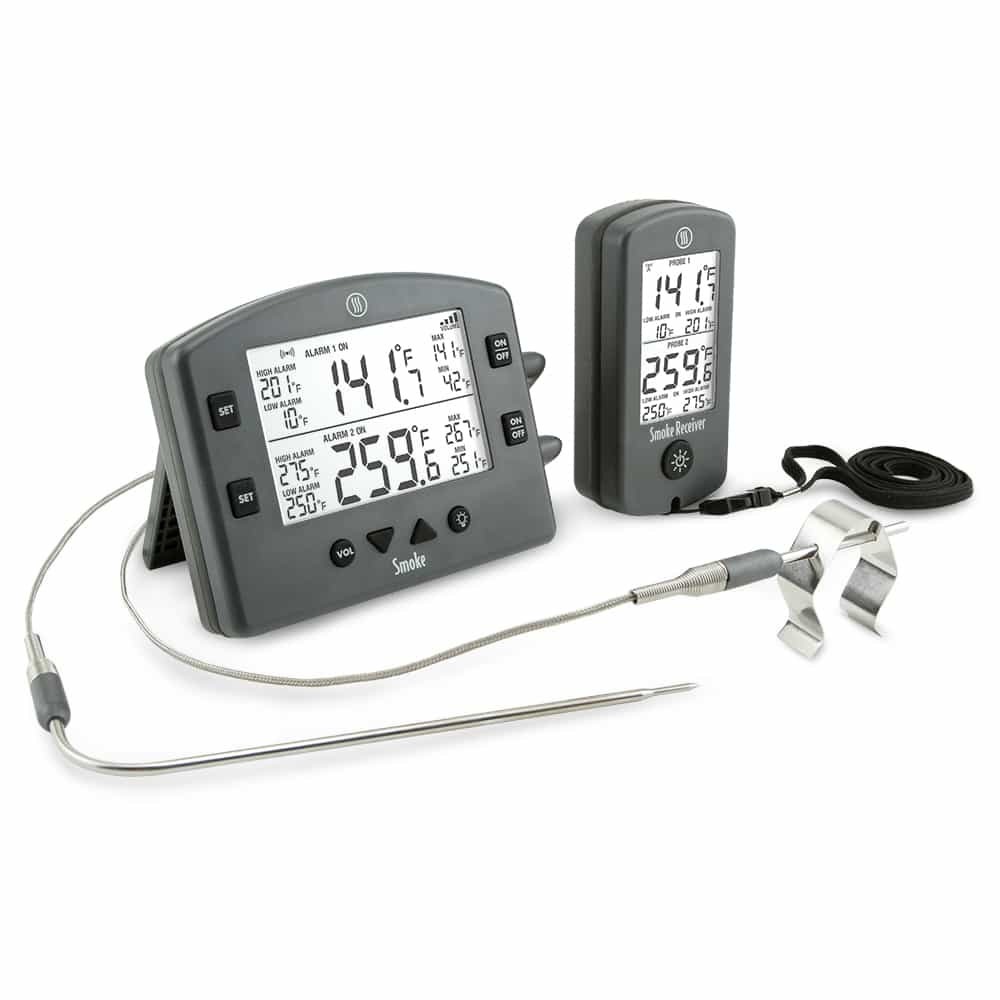
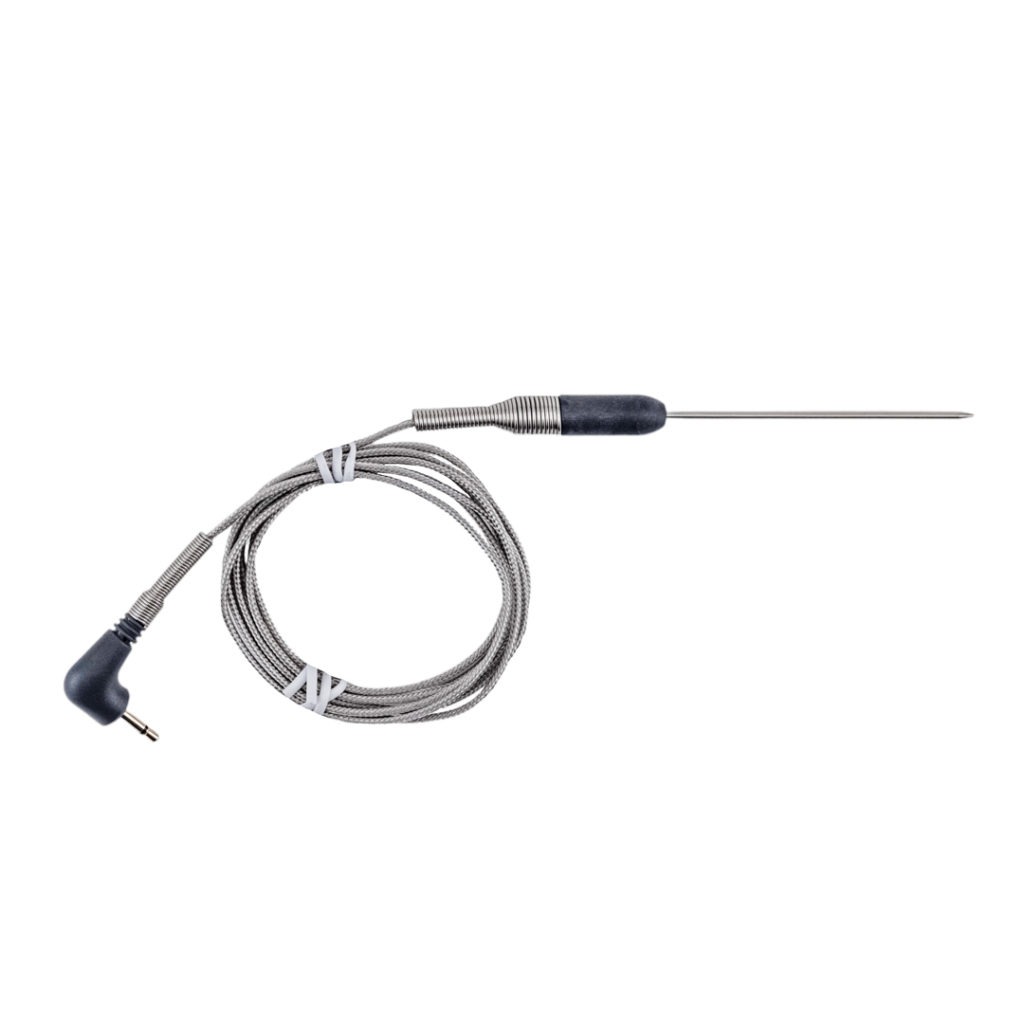
I never even thought about making hot dogs, but this inspired me to give it a try. I have all the tools (a cabinet full of ThermoPen thermometers, timers, silicon tools, everything), but no recipe. I’ve always avoided commercially-made hotdogs for fear of what they probably contain. Knowing that I might finally be able to control the product, I have to give it a try.
Do it! You’ll love them!
What about if I cannot smoke the links the next day. Should I freeze them and thaw overnight for the next day smoke or just keep well refrigerated for 1 to 2 days and then smoke?
Just keep them in the fridge for a day or maybe two until you can.
what wood chips work the best for the hotdogs for smoking
Apple, beech, or oak are best for thins in my opinion.
yummy
Very!
Looks good
My husband and I are salt sensitive, which is why I was looking to make the hot dogs from scratch. How will it effect the recipe if I lower the salt content?
It should still work fine, just be less flavorful.
Can I put them in hot water until they get to 145 temperature ?
Yes.
Do you have to use curing salt? Really dont want nitrates or stuff like that.
Yes, kind of. If you don’t their color will be a weird gray-brown and they will taste different. You can use celery juice, which is what all the “uncured” hotdogs, hams, and salamis use. But the reason they use them is because celery juice contains…nitrates. They nitrates that are assembled by a plant as a byproduct of their metabolism, as opposed to those obtained as a byproduct of refining sea salt, but are chemically identical. It’s a way they get to say their meats are uncured while definitely curing them.
I have a smoker bar, in which I stuff the chips into the bar, light the grille, and once the chips are smoking turn off the grille.
Do you think that will work? Or will I end up cooking to dogs?
It should work fine. Watch the temps, is all!
1.5 grams seems low for pink salt. Shouldn’t it be closer to 2.80 grams?
Because we’re not trying to PRESERVE the hotdogs or air dry them into beef sticks, we are only using the curing salt to color and flavor the meat. Cured meat tastes different than uncured meat, and it’s a flavor we definitely want in our hotdogs. The same goes for the color. So the lower dose is just fine here.
If I don’t have a smoker, can I just use my oven on a low temperature or boil them on the stove until the temperature gets to 145°?
Yes.
I altered and tweaked the recipe by buying Sabrett’s beef online, Vienna beef online and originial Farmer Johns pork (not Papa Cantellas). They came out best when I boiled a Sabrett or Vienna.
In steam bun with mustard or plain.
Yum
I’ve used that version of the recipe, too. Not bad…